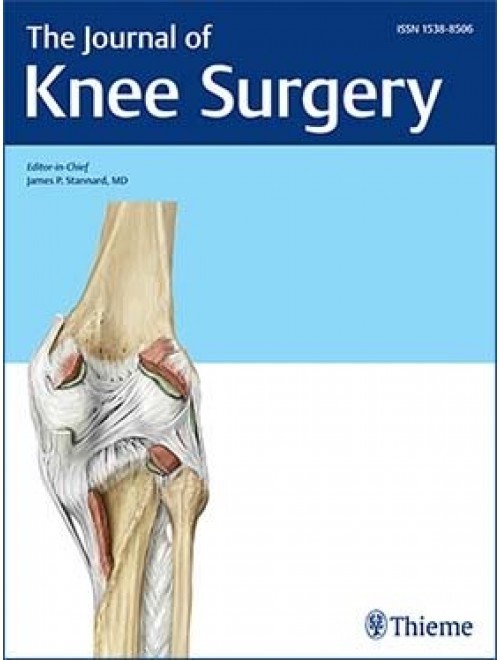
Comparing knee stability, subjective function, and OA development between DB & SB ACL reconstruction

Comparing knee stability, subjective function, and OA development between DB & SB ACL reconstruction
Single-Bundle versus Double-Bundle Anterior Cruciate Ligament Reconstruction: A Prospective Randomized Controlled Trial with 6-Year Follow-up
J Knee Surg. 2017 Nov;30(9):898-904Synopsis
60 patients requiring anterior cruciate ligament (ACL) reconstruction were randomized to either double-bundle reconstruction or single-bundle reconstruction. Patients were assessed for instrumented anteroposterior knee laxity (KT-2000), subjective function, objective functional performance on hop tests, and osteoarthritis development over 6-year follow-up. Results demonstrated no significant differences in any outcome measure between the two groups. One case of rerupture was recorded, occurring in the DB reconstruction group.
Was the allocation sequence adequately generated?
Was allocation adequately concealed?
Blinding Treatment Providers: Was knowledge of the allocated interventions adequately prevented?
Blinding Outcome Assessors: Was knowledge of the allocated interventions adequately prevented?
Blinding Patients: Was knowledge of the allocated interventions adequately prevented?
Was loss to follow-up (missing outcome data) infrequent?
Are reports of the study free of suggestion of selective outcome reporting?
Were outcomes objective, patient-important and assessed in a manner to limit bias (ie. duplicate assessors, Independent assessors)?
Was the sample size sufficiently large to assure a balance of prognosis and sufficiently large number of outcome events?
Was investigator expertise/experience with both treatment and control techniques likely the same (ie.were criteria for surgeon participation/expertise provided)?
Yes = 1
Uncertain = 0.5
Not Relevant = 0
No = 0
The Reporting Criteria Assessment evaluates the transparency with which authors report the methodological and trial characteristics of the trial within the publication. The assessment is divided into five categories which are presented below.
2/4
Randomization
4/4
Outcome Measurements
4/4
Inclusion / Exclusion
4/4
Therapy Description
4/5
Statistics
Detsky AS, Naylor CD, O'Rourke K, McGeer AJ, L'Abbé KA. J Clin Epidemiol. 1992;45:255-65
The Fragility Index is a tool that aids in the interpretation of significant findings, providing a measure of strength for a result. The Fragility Index represents the number of consecutive events that need to be added to a dichotomous outcome to make the finding no longer significant. A small number represents a weaker finding and a large number represents a stronger finding.
Why was this study needed now?
A prevalent comparison in research on outcomes following anterior cruciate ligament is single-bundle versus double-bundle reconstruction. More recently, emphasis has been placed on whether specific technical factors may influence if differences are found between groups or not.
What was the principal research question?
In anterior cruciate ligament reconstruction, does double-bundle reconstruction, using an independent tunnel drilling technique, provide significantly greater anteroposterior knee stability compared to single-bundle reconstruction, using a transtibial technique, assessed over 6-year follow-up?
What were the important findings?
- At final follow-up, there was no significant difference in side-to-side difference KT-2000 results between the DB group (1.4+/-0.6mm) and the SB group (1.3+/-0.8mm) (p=0.74).
- At final follow-up, there was no significant difference in Lysholm score between the DB group (96.4+/-17.3) and the SB group (94.2+/-15.3) (p=0.36).
- At final follow-up, there was no significant difference in IKDC score between the DB group and the SB group (p=0.23).
- At final follow-up, there were no significant differences between the DB group and the SB group in single hop distance (p=0.1528), crossover top distance (p=0.14) and the timed hop test (p=0.16).
- There was one case of rerupture (DB group).
- Medial compartment OA development was observed in 3 patients of the DB group and 2 patients of the SB group.
What should I remember most?
In ACL reconstruction, there was no significant difference in 6-year AP stability, subjective functional outcome, or objective functional performance between cases completed using double-bundle, independent tunnel drilling reconstruction and cases completed using single-bundle, transtibial drilling reconstruction.
How will this affect the care of my patients?
Mid-term follow-up to 6-year data appears to suggest that outcomes may be similar for double-bundle ACL reconstruction and single-bundle ACL reconstruction. There does not appear to be significant differences in subjective or objective function, AP stability, or OA development between the two techniques. Nonetheless, this study is one of only a few randomized trials to extend follow-up beyond 5 years in a comparison between double- and single-bundle reconstruction. Accordingly, additional data is needed to verify if there are indeed any differences in outcome between the two techniques.
Learn about our AI Driven
High Impact Search Feature
Our AI driven High Impact metric calculates the impact an article will have by considering both the publishing journal and the content of the article itself. Built using the latest advances in natural language processing, OE High Impact predicts an article’s future number of citations better than impact factor alone.
Continue



 LOGIN
LOGIN



Join the Conversation
Please Login or Join to leave comments.
Orthopaedic Surgeon - Canada
not surprised